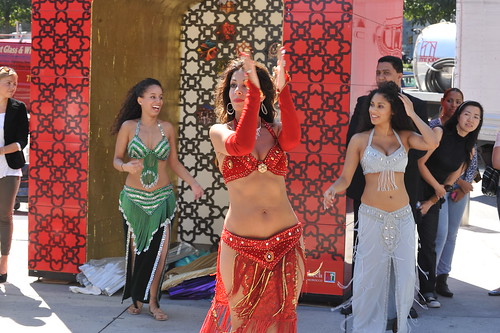Moroccan clothes are traditionally rich and varied - variety of fabrics, shapes and colors expressing a certain art of draping - Moroccan costume for man or woman comes by local cultures of each region or each social group.

Two major trends emerge, namely the urban dress and country dress, in both cases the use of various devices is used to enhance the look and divert the attention of potential weaknesses of the body.
The constant among men is wearing a Djellaba which is a loose clothing. Woolen fabric or lightweight, it is equipped with long wide sleeves and a hood.
Similarly, there is Silham or Burnous, solid color, black or white, borne on the Djellaba with hood.
Under Djellaba they wear the Caftan which is a long dress with no collar, long sleeves, closed at the front of many embroidered buttons.
For the head, Tarbouch as head covering for the urban and Razza for the country and Rural belgha (babouch, slippers) in both cases.
Moroccan clothes for women are also diverse.
The Haik, a sort of cloak of fine cloth large and white, is the rule especially in rural areas, and in certain regions. When you leave the city, you will see increasingly rural women in the female version of the djellaba.
They usually wear the Qmis(long jacket) underneath, a lightweight fabric covering a seroual (baggy pants).
The caftan and Mansouria fabric are the usual two long dresses for women. The Moroccan kaftan or caftan is for celebration and special occasions. This dress highlights the femininity with a bonus: it combines the splendor and elegance because of the meticulous production.
Fine fabrics and brightly colored silks are the traditional fashion. The tailors put their skill and art to create the sumptuous dress.
Gold embroidery, silver, contours and ends delicately decorated, all returning a sensation of richness and femininity.
A belt embroidered with silk thread or gold (or at least among wealthy women, silver or solid gold) shakes the Caftan size.This coat, has always been a source of inspiration throughout the world.
Moroccan Clothing Shop
Morocco is a country rich in history, traditions, people, and culture. Every part of these aspects influences how Moroccan people are dressed. Among the variety of clothes you will find in Morocco. The Djellaba and Gandora are the most common of Moroccan clothes.These fine garments speak of the luxurious clothing style of the country.
The djellaba, a typical robe that you cannot miss from the very first few seconds after arriving in Morocco. According to the many people we have met who have professed to be experts in many areas, there are three basic types of djellaba for men and two basic everyday options for women. For both sexes, the machzania or "government" djellaba is the most common throughout the country.
For Moroccan clothes for the men, there are also the northern and the southern djellaba, and for the women there is the kaftan. Iislamic religion of Morocco is also a key factor in the way that Moroccan people dress. The djellaba covers the whole body and is therefore an acceptable modest outfit.
The Gandora unlike the djellaba dosn't have a hood,and normally has short sleeves.
This Gandora has strong embroidery on the neck and sleeve openings,a pocket on one side and a slit on the other. Like the Djellaba the Gandora of all Moroccan clothes is a very traditional moroccan garment.
The traditional dress


The traditional dress for men is called a djellaba, a long, loose, hooded garment with full sleeves. For special occasions, men also wear a red cap called tarboosh and mostly referred to as Fez. Nearly all men wear babouches soft leather slippers with no heel, commonly in yellowbut also in many colours.
Many women do as well but others wear high-heeled sandals, often in silver or gold tinsel.
The distinction is the djellabas has a hood, while a Gandora does not. The women?s djellabas are mostly of bright colors with ornate patterns, stitching, or beading, while men wear djellabas in plainer, neutral colors. Women are strongly attached to their Moroccan clothes or "Moroccan wardrobe", despite the financial costs involved.
The production of such garments is relatively expensive, as most of the work is done by hand. Despite the costs involved most women purchase a minimum of one new kaftan or "tk'chita" every year, normally for a special, social event, such as a religious festival or a wedding. Nowadays, it is an unwritten rule that Moroccan dress is worn at such events.
The Gandora is very simular to the Djellaba the differance being the Djellaba has a hood and short sleeves. Masculine embroidery on the front around the neck and arms openings. For a convenient use, this garment has one slit on side and one pocket on the other side at the waist level.This gandora is made with cotton and is more suitable for summer use.
The origins of the fez, or "tarboosh" in Morocco, is not clear. The design may have come from ancient Greece or the Balkans. In the 19th Century it gained wide acceptance when the Ottoman rulers moved to modernize traditional costumes.









 .
.